Reading Peter Pan This Summer: A Classic Tale That Sparks Big Thinking for Ages 7–10
This summer, we decided to read Peter Pan together as part of our homeschool summer reading plan. My ten-year-old and I curled up with the original story by J.M. Barrie, and what started as a fun adventure turned into something much deeper. There’s something special about slowing down in the summer, soaking in a good book, and following it wherever it leads your imagination.
While most kids (and adults) know Peter Pan from the Disney ride at Magic Kingdom or the animated movie, reading the original novel gave us the chance to explore the full story and its richer themes. It’s filled with fun and whimsy, but also surprisingly thoughtful moments that open the door for great conversations.
Why Read Peter Pan?
Classic books like Peter Pan offer more than just entertainment. They introduce kids to new vocabulary, beautiful language, and ideas that stick with them. Even though this story was written over 100 years ago, the questions it raises still matter today.
The book begins with the famous line:
“All children, except one, grow up.”
That one sentence sparked a lot of reflection in our house. What does it mean to grow up? Why would someone want to stay a child forever? Can we keep some childlike wonder even as we age?
Peter Pan is playful and brave, but also complicated. He doesn’t want to grow up, and he doesn’t always understand emotions the way Wendy or the other characters do. These details gave us the perfect chance to talk about emotional growth, relationships, independence, and how people change over time.
What’s Inside the Peter Pan Novel Unit?
My Peter Pan Novel Unit is designed for ages 7 to 10 and includes everything you need to guide your child through the story while keeping the experience fun and meaningful. Here’s a quick look at what’s included:
Chapter-by-chapter activities
Vocabulary building activities
Writing prompts that build higher-level thinking
Creative and analytical questions
Geography tie-ins (hello, London and Neverland)
Social-emotional learning extensions
Science, History, and More
Each chapter includes a mix of questions and activities that move beyond just remembering what happened. We talk about character motivation, setting, and even science.
From Disney Ride to Classic Read
One of the most exciting parts of this unit is how it branches out from the Disney Parks experience. The Peter Pan ride at Magic Kingdom is beloved, and for good reason. You float through the stars and get a peek into Neverland. My kiddo is currently obsessed with hoping we get an in-show-exit from the ride. But reading the book brings the story into a whole new light. You get to know Wendy and you meet the Lost Boys as individuals. You hear Peter’s thoughts and feel the tension between childhood and growing up.
Even though this unit is focused on the book, it connects naturally to Disney experiences. If your child has seen the movie or been on the ride, they’ll already be familiar with the story’s surface. This novel unit invites them to go deeper. It's still magical, just in a different, more thoughtful way.
5 Questions to Ask After Watching the Movie
To make the most of the experience, I recommend watching the Disney animated movie after finishing the book (and because it’s over 100 degrees here in Central Florida at the moment… we are inside a lot!). Here are five questions that helped us reflect and compare:
How is Wendy portrayed differently in the book compared to the movie?
What emotions are explored in the book that don’t come across in the movie?
How does the ending of the book feel compared to the movie’s ending?
What details or characters are missing from the movie version?
Would you rather visit Neverland from the book or the movie? Why?
These kinds of questions help children think critically and give them a chance to express their preferences and ideas in a creative way.
Why Summer Is a Great Time to Read Peter Pan
Summer allows for slower mornings, longer afternoons, and fewer distractions. It’s the perfect time to pick up a classic and let it guide your learning and imagination. With the Peter Pan Novel Unit, your child can enjoy a story that is both familiar and full of surprises. It’s playful and fun, but also encourages reflection on big ideas like identity, fear of change, and the beauty of growing up.
Reading old classics helps children develop a broader perspective, introduces them to historical ideas and writing styles, and gives them tools to compare old stories with new ones. Plus, there’s just something timeless about Peter Pan. It invites readers of all ages to ask, “What if we could fly?” and “What if we never had to grow up?”
Ready to Start Your Adventure?
You can download the full Peter Pan Novel Unit here. It’s a great way to add meaningful learning to your summer without sacrificing fun. Whether you’ve just returned from the parks or you’re looking for a way to bring a bit of Disney magic into your homeschool, this unit offers the best of both worlds.




